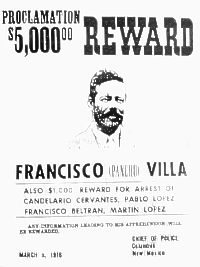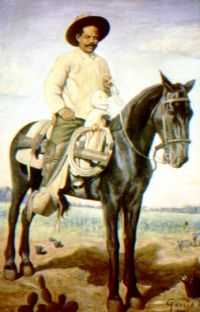Doroteo Arango, for that was Pancho Villa's real name, was born in the state of Durango in 1878, a share-cropper peasant on a hacienda. According to the legend, one day when he was sixteen, he returned home from the fields to find that his sister had been raped by the owner of the hacienda, Don Agustin López Negrete. Doroteo took up his revolver, shot Don Agustin, and escaped into the mountains on a horse.
He became a cattle rustler and later joined a band of rustlers that was led by a man named Francisco “Pancho” Villa. In one of their many skirmishes with the law, the group was surprised by a group of rurales (mounted police) and Francisco was killed. Doroteo then took command of the gang and also assumed the name of the fallen leader. He may have done this to throw off those who hunted him for the murder of the hacienda owner or he may have done this to insure his authority over the group. Anyway, from that time on it was he who was known as Francisco “Pancho” Villa.

Pancho Villa was a natural leader and was very successful as a bandit, leading raids on towns, killing, and looting. He was also involved in more legitimate ventures, including being a contractor on the Copper Canyon railroad.
In 1910, when the Mexican Revolution broke out, Villa was recruited by the revolutionary leader, Abraham Gonzalez. Villa put together an army of armed cowboys and ruffians and became the revolutionary general who led the war in the northern part of Mexico. His charisma and victories made him an idol of the masses.
In 1916, when an American merchant refused to deliver the arms to Villa's army which they had paid him for, Villa entered the United States and raided the town of Columbus, New Mexico. He was pursued by General “Black Jack” Pershing through the mountains of the State of Chihuahua. Pershing's pursuit of Villa ended in failure, causing him to telegraph back to Washington that “Villa is everywhere, but Villa is nowhere.”
The war ended in 1920, and many attempts were made on Villa's life by relatives of persons he had killed. On July 20, 1923, while driving his car through the town on Parral, Chihuahua, he was assasinated. The men responsible were never identified.
Click Here for information on our Copper Canyon Tours.



